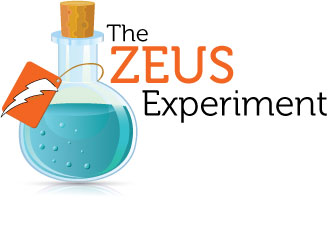A guest post by Zeus Yiamouyiannis.
What if, underneath it all, your carefully planned and wished-for life was nothing more than an adventurous experiment?
Would that free you or strike terror into your heart? What if you were both the guinea pig and the dude in the white lab coat?
What if your accomplishments were more like discoveries, scientific breakthroughs in the game of life? What would that make you?
I’ve come to realize that The Zeus Experiment is not just a plunge into online business. It is a leap into the core of who I am, and what my life might mean. There is no hiding in this endeavor. It’s a big bite to chew.
Most are familiar with the story of Thomas Edison, toiling alone in his lab, trying thousands of different things to make a working light bulb. Well, that story stretches the truth.
Thomas Edison didn’t even invent the light bulb, and he certainly didn’t do it by himself. He and his lab partners invented the first commercially marketable light bulb.
Thomas Edison’s genius lay in making technology practical and combining “entrepreneur” with “inventor.”
Closer to my heart is Buckminster Fuller, another great American inventor. Broke, jobless, and contemplating suicide after the death of his daughter, Fuller decided to treat his life as “an experiment, to find what a single individual [could] contribute to changing the world and benefiting all humanity.”
Fuller didn’t invent the geodesic dome, as most think, but he did develop it, patent it, and create commercially successful examples. 
Both Edison and Fuller worked hard and invented on their own, but they became successful by finding effective ways to implement their ideas and by getting support. So let’s get our Edison and Fuller on.
We’ll need tenacity and outrageousness, humanity and creativity, and a good dose of help.
AWeber, what?
So I tried installing AWeber’s email subscriber service. Apparently it has a good reputation, but getting the service up and running has been high-tech comedy.
I’ll be calling AWeber’s customer service to find out why their text instructions are scrolling up behind their template on the Mac I am using, why the videos are not working, and why they use tech code like {c!name} in their subject line set up for welcome emails instead of just allowing me to type what I need.
I’ll also suggest that they develop a checklist and a simple explanation of the basic first follow-up messages, so I can actually be prepared with my text as I do the installation.
After talking to Tea, I’m less vague on how autoresponders are intended to work. Apparently there are basically three kinds of emails I can write when using AWeber — and only one type is an actual autoresponder:
- Follow-up – This is where my welcome emails and autoresponders live. When someone signs up to my list, they receive these pre-written (by me) messages in the order I designate. It could be one simple welcome email, or a whole series.
- Broadcast – Like a newsletter, keeps people current and involved and gives them a consistent reason to open your emails; and
- Blog broadcast – Allows me to automatically alert subscribers every time I post something new to my blog (uses RSS technology).
Tea also informed me that I may want to have some kind of product to give away to boost subscriptions to my email list. Oh, yeah, that…
So I am stepping back to bring the things I need together. My subscription box (on my website) still isn’t working. I’m still putting together my own framework for how I want my emails to work (all while I work out the technical kinks). I’ll share that framework in my next post. Promise.
In the meantime, I’m looking for cheap, competent help here in the Philippines (where I’m living) to iron out the technical snags so I can optimize Tea’s and my time in our weekly chats. (Breathe in, breathe out… “Buckminster Fuller, Buckminster Fuller, Buckminster Fuller.”)
***
A Word from Tea
When you’re trying to launch a new business, unless you come to the table with a fat wad of cash, you should (rightly) keep your purse strings drawn tightly. Don’t use your credit cards if you can help it. If you come to the table with NO cash, then you’re going to have to figure out every little thing yourself. Or wait until you have some cash to pay for the help.
Where I went wrong with Zeus was that I assumed he had no cash to inject into his business. We discussed the fact that he needed to keep his expenses ultra-ultra-low. But we didn’t draw the line between No and Low budget.
When you absolutely have to figure things out on your own, there’s plenty of free help on the interwebz (or here on this site) and you can usually find the right tutorial.
But sometimes, the tutorials don’t do the job. Usually because the version of your thing doesn’t match the version the instructor’s using. Or, even worse — the instructor has no clue about how to teach something.
When that happens, the gap between your knowledge and getting it done will continue to widen at an exponential rate if YOU try to close it yourself. Sometimes you’ve got to just buckle down and pay for things.
What’s your time worth? What are you focusing on? These are the questions you need to answer before you dive in to a project that will require you to learn things you’ll probably never need to know ever again. Don’t get me wrong — it’s great to learn new things. Especially if you want to be able to manage someone else helping you with it. But if you’re spending more than a week on something that should rightly take just an hour or two, you’ve strayed off the path. Time to call in an expert!
photo credit: JoshuaDavisPhotography via photo pin cc









I *still* haven’t got my site up and running, and I started it two months ago…so you are way ahead of the curve in my book, Zeus. I will watch for your email list to be live.I’m stuck on the “something to give away” thing, too.And your Edison and Fuller references resonated with the geek in me, though my personal favorite is Tesla. I love his sometimes poetic autobiography and the fact that had he had crazy out-of-body experiences. Too bad he never developed Edison’s business sense.